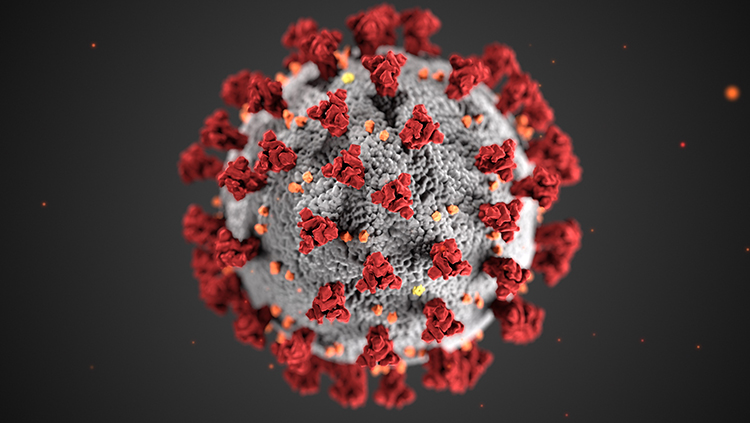
The COVID-19 pandemic will be long remembered because of the death toll it caused worldwide and how it impacted our everyday lives. It is also still remembered because of some long-term effects of the viral infection which have been coined as “long COVID”. Long COVID covers an ensemble of signs and symptoms that persist, develop, or fluctuate four weeks after the acute SARS-CoV-2 infection (NIH definition).
Although the entity is not well defined and covers multiple systems, as neuroscientists, the Committee for Higher Education and Training (CHET) at FENS was interested in knowing more about the frequent neuropsychiatric symptoms that have been reported in this condition. These include: fatigue, sleep disorders, mood alterations, headache, impaired concentration, memory loss, dizziness, which can persist for months. All of these symptoms are a burden to patients and society, as their prevalence is high — somewhere between 30-50% of the infected patients according to retrospective studies — and are yet poorly understood.
Two researchers, a psychiatrist and a child neurologist, working in the fields of immunity and neuroinflammation have answered a few questions on what the current understanding of long-term neurological effects of COVID-19 is.
First, could you give a quick background on how you got involved in the topic of long COVID?
Pariante: As a neuroimmunologist and psychiatrist I have been naturally interested by long COVID as a model of the interaction between immune system alterations and the brain and potential consequences for mental health. My main area of research in this field has been to look at some of the molecular mechanisms through which immune activation in patients during acute COVID could cause impairments of brain function, especially affecting neurogenesis and neuronal apoptosis. Although I have never directly worked with long COVID patients, I was interested by long COVID as a model to understand how the immune system and the brain communicate. I also conducted research on chronic fatigue syndrome, which can be seen as a similar condition as long COVID since chronic fatigue syndrome is often triggered by acute viral infections.
Gressens: As a researcher working in the field of neurodevelopment and inflammation and as a child neurologist, I became interested in understanding the long-term effects of COVID since COVID infection in children like many other inflammatory diseases could have important long-term consequences for brain development.
What is the current evidence for neurological and psychiatric disorders in the follow-up of COVID infection?
Gressens: Several studies have shown that there are long-term consequences of COVID at the brain level. These consequences appear more important in adults than in children. However, the relative frequency of these alterations remains debatable. Indeed, epidemiological studies have used the C Y P concept in children and young people, where the limit between young people, adults, is not always clearly defined. But, yes, there is evidence. The numbers are a bit variable. In adults, nationwide studies are showing relatively clear long-term effects. Numbers for children, are still unclear, but based on a meta-analysis of the literature, the overall prevalence of long-COVID in children and adolescents was estimated to be about 25% (1), with the highest frequency of neuropsychiatric symptoms such as mood symptoms (16%), fatigue (10%) sleep disorders (8%), cognitive symptoms (6%). This is probably less than in the adults over the same time period, but maybe also less reported because sometimes children do not report these kinds of issues while the adults have a tendency to be more responsive to questionnaires for instance.
Pariante: The evidence is quite strong. We know, for example, that, as part of the broad constellation of symptoms involving long COVID, there is an increase in depression, anxiety, and sleep disturbances. There are also symptoms of fatigue. We know from published research that high inflammation during the COVID infection predicts a higher risk of developing mental disorders, especially depression, anxiety, over the subsequent months (2). Also, there is evidence that people with higher level of mental distress or depression or anxiety before COVID infection are more at risk of developing long COVID after the infection Of course, it is important to stress that this does not mean that long COVID symptoms are “psychological phenomena” simply due to the distress of the illness. We know that there are biological abnormalities underpinning the long COVID symptoms, and it is particularly interesting that these biological abnormalities might be related to the immune system. We now start understanding the biological pathways through which increased inflammation affects the brain and induce depression, anxiety, and fatigue.
A similar condition as long-COVID is the chronic fatigue syndrome or other post-viral or post-infectious fatigue syndrome. During the acute phase of infection, some individuals are particularly predisposed to a hyperreactive immune system, which then could theoretically create long-standing changes in brain function. This could in turn lead to the constellation of symptoms that we interpret as long COVID or chronic fatigue syndrome for other infections previous to COVID. However, our understanding of such factors that could lead to these long-term effects on the brain is still unclear.
What do we know about the pathophysiology of these disorders? And what are your current thoughts on the entry point to the virus and to the brain and the way it affects brain function?
Pariante: The pathophysiology of long COVID is still unclear. We know that, in some people, some of the symptoms are predominantly around lung function and breathlessness, and there might be permanent lung involvement. Similarly, there is evidence that micro thrombosis could affect how blood oxygenation reaches the tissues. However, how the virus affects the brain, is still unclear. Different possibilities, have been formulated, including entry of the virus itself, through the olfactory nerves, or through circulation. However, many of the described brain alterations could be a consequence of the immune activation which occurs during the acute phase of COVID: the level of immune activation is so high then that that's more than enough to affect brain function.
We recently published a study of patients who had COVID during the first wave of infection and had a particularly severe acute infection (3). Some of these patients had delirium symptoms which clearly identified involvement of the brain (confusion or emotional and behavioral changes). COVID-infected patient with delirium had the highest level of circulating interleukin 6 (IL-6) in the serum compared with COVID-infected patients without delirium. This indicates a direct link between activation of the immune system and involvement of the brain at a functional level during the acute infection. Further in vitro work from our laboratory showed that one pathway through which IL-6 could affect brain function is by reducing neurogenesis and increasing apoptosis. Thus, some of the pathways through which the immune activation during acute infection can affect the brain do not require the virus to penetrate the brain. This acute immunological response could create a predisposition to long COVID and symptoms such as anxiety, depression, fatigue, or disturbance of sleep. However, this still remains to be demonstrated.
Gressens: There are no studies about mechanisms of pathophysiology in children, nothing, not even in models. There are even no neuroimaging MRI studies, for example, to look at the brain structure of children with COVID. Also, we do not have postmortem studies, as has been done in adults because luckily enough, not many children die with long COVID, which is the good news. What has been studied in children are just the clinical symptoms (reviewed in Lopez-Leon et al. Scientific reports, 2022), very often without any control groups, which is also an issue.
Overall, we have to refer to studies in adults knowing that the developing brain is not just a small brain. It is very different from an adult brain in terms of potential for the virus, potential mechanisms. Among the brain lesions identified in the adult brain, such as white matter damage one can hypothesize that myelin alterations would be more important in children , because we know that the white matter of the developing brain is very sensitive to neuroinflammation. But this is just a hypothesis because there are no actual studies.
In terms of possible mechanisms, we can only speculate at this point because of the lack of data. We need studies in children or least in models replicating the developing brain. The mechanisms could be identical, similar, or very different from the adults. But we have no idea at this point.
What do we currently know about the evolution of these neurological sequelae of COVID infection? How pervasive are they?
Pariante: The epidemiology is slightly different in different countries and based on how neurological sequelae are measured or interpreted. There is evidence that a number of people still have symptoms months or now approaching years after the infection. In most patients there is a gradual spontaneous remission or improvement over time, and some patients only experience symptoms during the first few weeks after the infection. It's a varied phenomenon. It is also still difficult to understand why some people develop a more long-term condition. As mentioned above, data have shown some relationship with the level of severity of the actual acute infection (3). It is possible that one of the factors contributing to the long COVID is the acute activation of the immune system during the acute infection, that then affects brain function. But again, we are just at the beginning of understanding this phenomenon. Of course, because of the sheer number of people infected by COVID, even if just a small percentage of them show persistent symptoms, that is an important clinical and social problem. These are people who may feel physically, socially, or economically impaired. They may have difficulties in going back to work and experience mental distress and physical symptoms, so, it is an important clinical population.
Gressens: What we know, which is a bit counterintuitive for me, is that most of the long-COVID cases in children are between zero and three years of age. I was expecting that the adolescents would report more long-term consequences, but this is not the case. More than 50% of the reported cases are very small children. It might be because these kids are more prone to experience long COVID or because cases in toddlers are reported by the parents while older children do not report the symptoms or consider them as part of their life. We do not have long-term or longitudinal studies to know the evolution of long COVID in children. The World Health Organization, WHO, suggests that symptoms could disappear within a few months, but there are no solid data to support this. It is a critical issue because, of course, if symptoms last for a few weeks this is not a big deal. But if symptoms last for months or years, it becomes a real burden. Since the most classical brain consequences are mood disorders, fatigue, sleep disorders, headaches, cognitive impairment, this could really impact school performance. Your question is really critical, but we don't have the information.
In the pediatric field the possible consequences of COVID for developmental brain disorder are not known. Ninety-five percent of the studies are just descriptive with no control group, no follow up or long-term outcome. For example, some studies suggested that autism was increased in children with long-term COVID but did not have a control group.
In South Africa – a study indicated that TB, tuberculosis, or HIV, increased the risk, up to 10 times the risk to have long-term COVID. If this is true, it would mean that low socioeconomic populations and their children would be also at higher risk. Again, it could be not just medical but also a social impact on long-term COVID. And unless we search for it, we won't find it because these families won't go to the hospital on their own.
References
1) Lopez-Leon S, Wegman-Ostrosky T, Ayuzo Del Valle NC, Perelman C, Sepulveda R, Rebolledo PA, Cuapio A, Villapol S. Long-COVID in children and adolescents: a systematic review and meta-analyses. Sci Rep. 2022;12:9950.-9956.
2) Wang S, Quan L, Chavarro JE, Slopen N, Kubzansky LD, Koenen KC, Kang JH, Weisskopf MG, Branch-Elliman W, Roberts AL. Associations of Depression, Anxiety, Worry, Perceived Stress, and Loneliness Prior to Infection With Risk of Post-COVID-19 Conditions. JAMA Psychiatry. 2022;79:1081-1091.
3) Mazza MG, De Lorenzo R, Conte C, Poletti S, Vai B, Bollettini I, Melloni EMT, Furlan R, Ciceri F, Rovere-Querini P; COVID-19 BioB Outpatient Clinic Study group; Benedetti F. Anxiety and depression in COVID-19 survivors: Role of inflammatory and clinical predictors. Brain Behav Immun. 2020 ;89:594-600.









